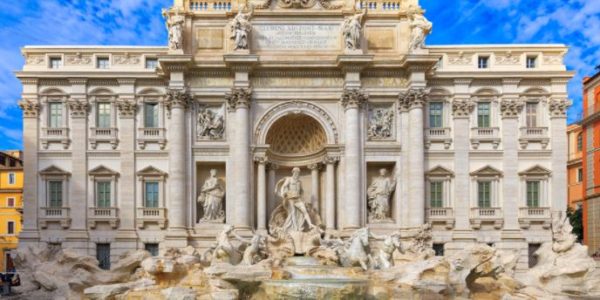We tend to think that any day you’re traveling is a pretty lucky one, but if you’re looking to pack an extra dose of prosperity into your next trip, these locations offer you the chance to get fortune on your side.
Whether it’s good health, a prosperous career or to be lucky in love, these fountains, statues, temples and traditions may be your golden ticket to your biggest wishes granted.
Here’s a list of them below:
1. Blarney Stone, Cork, Ireland
They don’t call it the luck of the Irish for nothing! Legend has it that that kissing the Blarney Stone at Blarney Castle in Cork, Ireland will bring you “the gift of the gab.” Sir Winston Churchill and Mick Jagger have both reportedly made their luck at this very site. To kiss the “Stone of Eloquence,” visitors must lean backward (holding onto an iron railing) from the parapet walk.
2. Fountain of Wealth, Suntec City, Singapore
Listed by the Guinness Book of Records in 1998 as the largest fountain in the world, the Fountain of Wealth is located in one of Singapore’s largest shopping malls, Suntec City. The fountain is said to be overflowing with qi (positive energy), which visitors can absorb by touching the water. The fountain is turned off periodically throughout the year, giving visitors the chance to walk around the smaller fountain and collect coins, which are believed to possess charm and good luck.
3. Abraham Lincoln’s Tomb, Illinois, USA
The final resting place of the 16th President of the United States, Abraham Lincoln’s tomb is decorated with statues, but none quite as iconic as the large bronze bust in front of the memorial. A whopping 200,000 people visit the tomb each year, many rubbing Abe’s nose. Some believe that rubbing the nose of any statue brings good luck, and with the nose of a person successful enough to become the president within arm’s reach, it makes sense people take advantage.
4. Lingyin Temple, Fei Lai Feng Scenic Area, China
One of the largest and most visited Buddhist temples in China, Lingyin Temple or Temple of the Soul’s Retreat holds the largest statue of the Buddha Sakyamuni in the lotus position. Numerous Buddha statues reside at this large monastery in southeast China, including a laughing Buddha, Maitreya. Situated in the centre of the Hall of the Heavenly King, it’s believed rubbing this Buddha’s bare fat belly brings good fortune.
5. Statue of Juliet, Verona, Italy
One of the most iconic attractions in Verona, Italy resides in a charming courtyard outside of a 14th-century building billed as the home of William Shakespeare’s Juliet. It has become a tradition for visitors to touch the right side of the statue’s chest for good luck.
6. Fushimi Inari Taisha, Kyoto, Japan
An important Shinto shrine in southern Kyoto, Fushimi Inari Taisha is dedicated to the god of rice and sake. Merchants and manufacturers have traditionally worshipped Inari as the patron of business. Entrepreneurs and various other tourists alike visit this 8th-century shrine to pray for bountiful harvests, success in business, and the hope of their wishes and dreams coming true.
7. Magic Owl of Dijon, Dijon, France
For more than 300 years, this carving has served as the city of Dijon’s symbol and unofficial talisman. Sitting about 1.8m off the ground, it is believed that if you touch him with your left hand and make a wish, your wish will come true. Damaged by vandals in 2001 and repaired soon after, no one questions that the owl’s luck lives on.
8. Everard ‘t Serclaes Statue, Brussels, Belgium
Located on the street near the Grand Palace, this statue represents a Brussels resident who led efforts to reclaim the city following a Flemish attach in 1356. Thanks to his success, Everard ‘t Serclaes’ body, along with an angel’s face, a dog’s face and a shield, are rubbed regularly by tourists in search of good luck.
9. Witch Market, La Paz, Bolivia
Who would have thought that something so dreadful to the eye could be considered lucky? The Witch Market in Bolivia is home to dried llama foetuses, dried frogs, and dried turtles, along with soapstone carvings, aphrodisiac formulas, and other folk remedies made by onsite witch doctors. The dried llama foetuses are the main attraction, however; burying a foetus in the foundation of your building or somewhere in your yard is thought to bring good luck as it’s considered an offering to the goddess Pachamama.
10. Statue of St. Anthony’s Pig, La Alberca, Spain
Within the historical and medieval Spanish village of La Alberca resides a special pig statue outside the parish church. Every year, a blessed pig is released into the village, where it roams the streets and feeds from the hands of the residents. At the conclusion of the festival, the pig is raffled off to one of the families who can then do whatever they please with it. The statue is a symbol of the festival, with childless couples yearning for offspring known to rub its baby-making parts for good luck.
11. The Guardhouse Monkey, Mons, Belgium
Located just outside of the Mons City Hall in Belgium resides a small metal monkey that has become a big attraction. Legend has it that if you rub the sculpture’s head, you’ll be granted good luck. The monkey’s head has been rubbed so many times in hopes of granting people their wishes that its head is now a shiny chrome dome.
12. Hoover Dam, Nevada, USA
The iconic Hoover Dam, a concrete arch-gravity in the Black Canyon of the Colorado River, is located on the border between Nevada and Arizona in the US. While beauty exists on both sides of the river, luck is found only on one side. Touching the toes of The Winged Figures of the Republic on the Nevada side is said to bring good luck.









